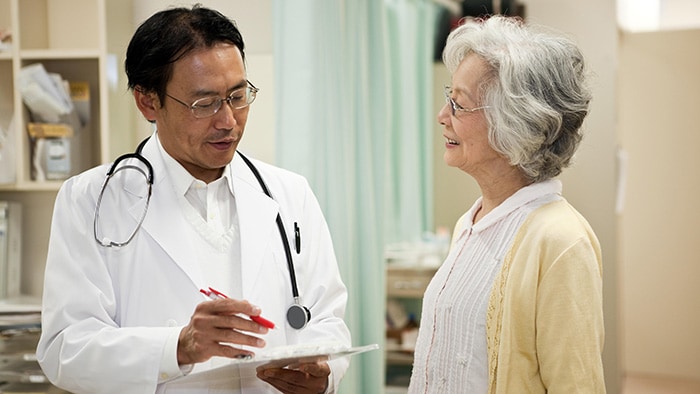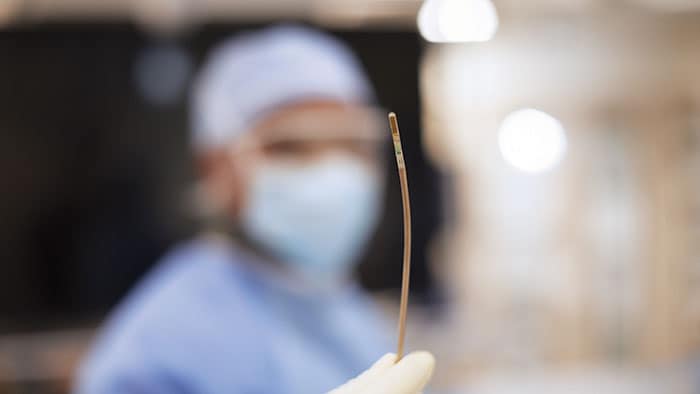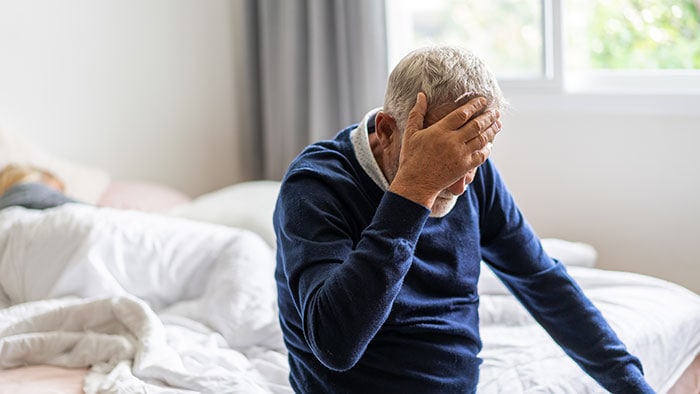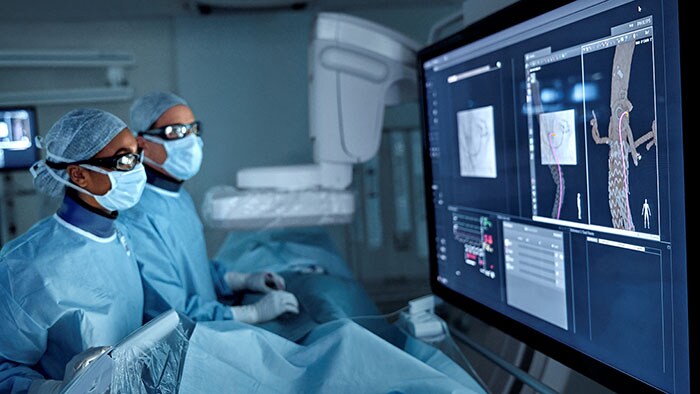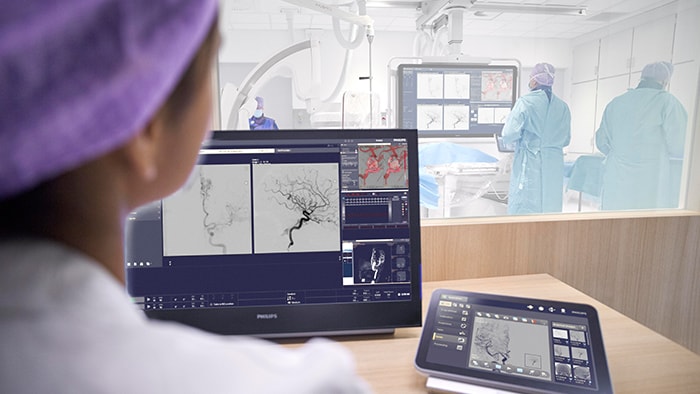Philips Azurion & Design in Algemeen Dagblad: ‘Opereren vanuit de cockpit’
jul 02, 2025 | 3 minuten leestijd
Om betere zorg voor meer mensen toegankelijk te maken, zet Philips zich in om oplossingen te ontwikkelen die zo goed mogelijk aansluiten bij de behoefte van de patiënt en zorgverleners. Een voorbeeld daarvan is de Azurion Neuro Biplane, het geavanceerde beeldgeleide-interventiesysteem dat onlangs in de prijzen viel voor zijn ontwerp. In een artikel van het Algemeen Dagblad vertellen Philips-ontwerpers Dirk Vananderoye en Ivo Stuyfzand over het design van de Azurion, waarin de mens centraal staat.
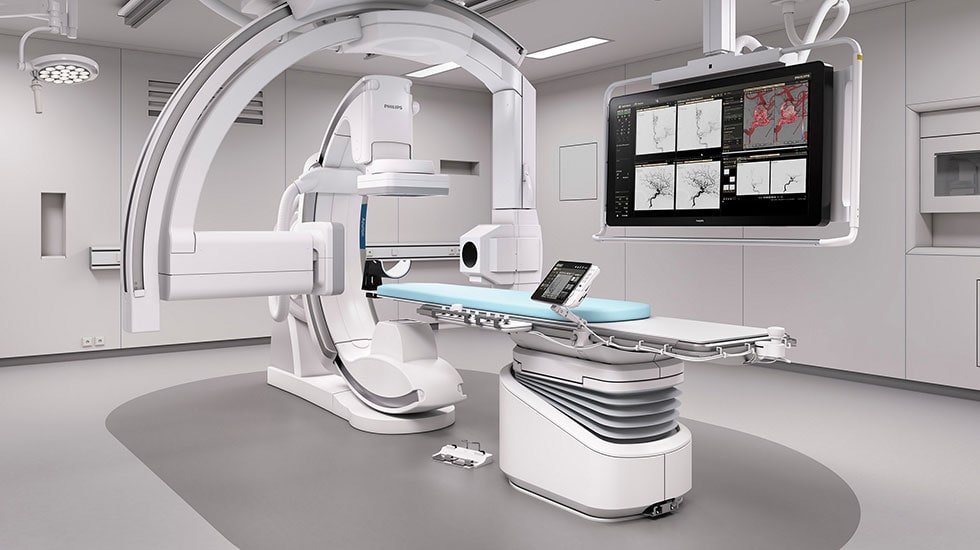
Mensgerichte ontwerpers
Designers Dirk en Ivo zijn al ruim tien jaar betrokken bij de ontwikkeling van Azurion. Hun doel is om producten zo te ontwerpen dat ze naadloos aansluiten bij de behoefte van de gebruiker. Ze noemen zichzelf dan ook ‘uitvinders die ervoor zorgen dat technologieën makkelijk te gebruiken zijn.’ “Human-centered design maakt het verschil. Het zet de mens centraal, zorgt ervoor dat het product maximaal functioneert’’, zegt Vananderoye. Dat betekent ook dat de ontwerpers van Philips vanaf stap één samenwerken met mensen uit de praktijk. Dirk: “Bij de ontwikkeling van Azurion waren we vanaf het begin betrokken. Om zicht te krijgen op de haalbaarheid, de kosten en op de vraag ‘wanneer zetten we het in de markt’. Samen met technici, inkopers en marketeers proberen we iets te maken.”
Intuïtieve Azurion
Dat leidde uiteindelijk tot de introductie van de Azurion. Met de nieuwste generatie van het beeldgeleide-interventiesysteem van Philips, kunnen artsen zogeheten minimaal-invasieve ingrepen uitvoeren via kleine gaatjes, ter grootte van de punt van een potlood, in plaats van grote openingen. Voor de ontwerpers van Philips was het van extra belang dat de apparatuur logisch en intuïtief te gebruiken is; de ontwikkeling van het controlepaneel duurde mede daarom vier jaar. Dat resulteerde in een paneel dat precies doet wat de gebruiker verwacht en zonder weerstand een 900 kilo zware flexibele arm met de apparatuur voor de röntgenstraling aanstuurt. Ivo vat de ontwerpfilosofie van de Azurion samen: “Pas als mensen zeggen dat iets prettig is in gebruik, ben je klaar.”
Design in beweging
Hoewel de mensgerichte benadering niet verandert, is het zaak dat de ontwerpers van Philips continu blijven innoveren om in te spelen op uitdagingen in de gezondheidszorg. Zo is het werk in de operatiekamer complexer geworden. Philips speelt daarop in door technologie te ontwikkelen die ervoor zorgt dat alle apparatuur in een OK bestuurd kan worden en alle informatie vanaf één plek zichtbaar is, aan de operatietafel sta je als het ware in een ‘cockpit’: “Je bedient via een beeldscherm eigenlijk zes laptops in één keer met verschillende applicaties die wij hiervoor hebben ontworpen. Je kunt beelden snel wisselen, uitvergroten,” vertelt Ivo.
Materiaal is ook van belang in het ontwerpproces. Zo is de rail van het controlepaneel van roestvrij staal en ‘buikhangproof’, zodat artsen niet per ongeluk toetsen indrukken. Duurzaamheid speelt ook een rol bij het materiaalgebruik, stelt Dirk: “Deze stralingsboog gebruikt minder dan de helft van de röntgen in vergelijking met vorige systemen.” Ook over geluid en kleur wordt nagedacht in het multidimensionale designproces.
Al die aspecten zijn erop gericht om een mensgericht product te kunnen ontwerpen dat naadloos aansluit op de behoeften van het zorgpersoneel. Daarom blijven de ontwerpers betrokken bij de praktijk. Het tweetal bezoekt ziekenhuizen over de hele wereld om te leren van ervaringen van patiënten, zorgpersoneel en anderen. Ivo: “Dan zie je ook het verschil in procedures en werksfeer.’’ Dat leidt ook tot nieuwe inzichten over technieken in de operatiekamer, waardoor nog meer intuïtieve, gebruiksvriendelijke producten ontwikkeld kunnen worden. “Het klopt helemaal als we zien dat een team in de OK zijn werk doet als een symfonisch orkest,’’ vat Dirk samen.
Klik hier om het volledige artikel te lezen.
Philips Azurion & Design in Algemeen Dagblad: 'Operating from the cockpit'
To make better care accessible to more people, Philips is committed to developing solutions that best meet the needs of patients and caregivers. One example is the Azurion Neuro Biplane, the advanced image-guided intervention system that recently won awards for its design. In an article by the Algemeen Dagblad, Philips designers Dirk Vananderoye and Ivo Stuyfzand talk about the human-centered design of the Azurion.

Human-centered designers
Designers Dirk and Ivo have been involved in the development of Azurion for more than a decade. Their goal is to design products so that they fit seamlessly with the user's needs. As such, they call themselves "inventors who make sure technologies are easy to use. "Human-centered design makes the difference. It puts people first, makes sure the product functions to its maximum potential,‘’ says Vananderoye. That also means that Philips' designers work with real-world people from step one. Dirk: "In the development of Azurion, we were involved from the beginning. To gain insight into the feasibility, the costs and the question ‘when do we put it on the market’. Together with technicians, purchasers and marketers we try to make something."
Intuitive Azurion
That eventually led to the introduction of the Azurion. With the latest generation of Philips' image-guided intervention system, doctors can perform so-called minimally invasive procedures through tiny holes, the size of the tip of a pencil, instead of large openings. For Philips' designers, it was especially important that the equipment be logical and intuitive to use; development of the control panel took four years partly for this reason. That resulted in a panel that does exactly what the user expects and controls without resistance a 900-kilo flexible arm with the X-ray equipment. Ivo sums up the Azurion's design philosophy: “Only when people say something is pleasant to use, are you finished.”
Design in motion
While the human-centered approach is not changing, it is imperative that Philips' designers continue to innovate to respond to healthcare challenges. For example, work in the operating room has become more complex. Philips is responding to this by developing technology that ensures that all equipment in an OR can be controlled and all information is visible from one place; at the operating table, you are in a “cockpit,” so to speak: "You actually operate six laptops at once via one screen with various applications that we have designed for this purpose. You can switch images quickly, magnify them," Ivo says.
Material is also important in the design process. For example, the rail of the control panel is stainless steel and “belly hang proof,” so doctors don't accidentally press buttons. Sustainability also plays a role in the use of materials, says Dirk: “This radiation arc uses less than half the X-ray compared to previous systems.” Sound and color are also considered in the multidimensional design process.
All these aspects are aimed at designing a people-oriented product that seamlessly meets the needs of healthcare personnel. That's why the designers stay involved in the field. The pair visit hospitals around the world to learn from the experiences of patients, care personnel and others. Ivo: "Then you also see the difference in procedures and working atmosphere.'' That also leads to new insights about techniques in the operating room, allowing even more intuitive, user-friendly products to be developed. "It's absolutely right when we see a team in the OR doing its work like a symphony orchestra,‘’ Dirk summarizes.
Click here to read the full article (in Dutch).


